| Xilinx CoolRunner Outperforms All Other CPLDs!
The Xilinx CoolRunner XPLA3 family, with its ultra low standby and total current consumption, is the world’s lowest power CPLD. Additionally, CoolRunner devices radiate the lowest amount of heat and are a perfect solution for heat sensitive
applications. Heat problems can manifest themselves in many of the following ways:
|
Heat Disadvantages
|
Added costs
|
- Higher FIT (Failures In Time) rate
- Intermittent field failures
- Higher cabinet or enclosure design and manufacturing costs
- Extra cooling vents that encourage failure of EMI/RFI testing
- Mechanical stress to package parts near high heat dissipating devices
|
- Larger power supplies
- Larger cooling fans
- Heat sinks
- PCB layout issues
|
Thermal Emission:
Even in low power mode, competitor devices dissipate more heat than CoolRunner CPLDs:
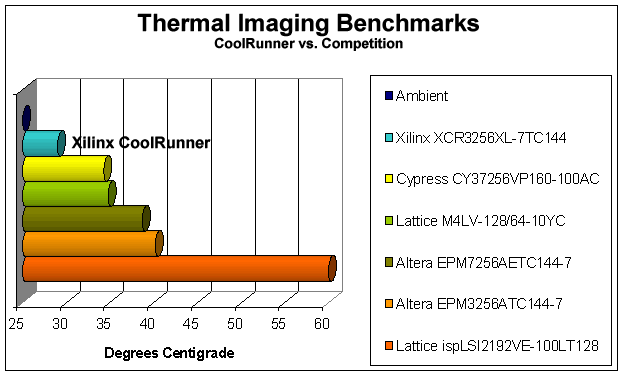
We compared a CoolRunner XPLA3 256 Macrocell CPLD against similar CPLDs from Altera, Lattice and Cypress. A total of 5 different families were used: the Altera MAX7000AE and MAX 3000A family, Lattice’s M4LV and ISPLSI2000VE
family, and Cypress’ Ultra 37000V family. Table 1 below shows the devices used in this experiment:
|
Table 1. Devices used in Experiment
|
|
Vendor
|
Family
|
Device
|
Macrocells
|
|
Xilinx
|
XPLA3
|
XCR3256XL TC144-7
|
256
|
|
Altera
|
MAX7000AE
|
EPM7256AETC144-7
|
256
|
| |
MAX3000A
|
EPM3256ATC144-7
|
256
|
|
Lattice
|
MACH 4LV
|
M4LV-128/64 -10 YC
|
128 (1) |
| |
ispLSI2000VE
|
ispLSI 2192VE-100LT128
|
192 (2)
|
|
Cypress
|
Ultra 37000
|
CY37256VP160-100AC
|
256
|
|
Notes:
- Due to lead times, a 256 Macrocell MACH 4LV part could not be obtained. A 128 Macrocell M 4LV part was substituted.
- Lattice’s ispLSI2000VE family offers no equivalent 256 Macrocell part so the highest density device was used (192 macrocells).
|
How we tested
All parts were programmed with as many 16-bit counters as possible. The 256 Macrocell devices were programmed with a total of sixteen 16-bit counters, the Lattice ispLSI 192 Macrocell part was programmed with twelve 16-bit counters
and the Lattice Mach 4LV 128 Macrocell part was programmed with eight 16-bit counters.
In order to give the competitive devices a fair comparison, they were programmed in non-turbo mode. This allows lower power dissipation at the cost of speed. It is important to note that Xilinx CoolRunner parts do not have,
nor need, a non-turbo mode.
Lab Setup: Each device was mounted on an individual PC board. A 50 MHz Crystal Oscillator generated clock signal was routed to the devices through a terminated connection. All designs had a clock input, one control input to set the
mode of operation, and one output to verify circuit operation. Figure 1 shows the lab setup used in the experiments.
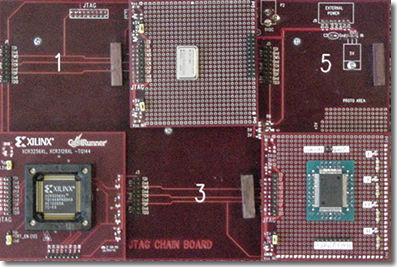
Figure 1: Lab Setup
Thermal Imaging Test Results
The following pictures were taken with Infrared Solutions, Inc. IR SnapShot® camera. In all cases, P2 represents CoolRunner and P1 represents the competitor part, while P3 represents the ambient temperature.
Xilinx XCR3256XL vs. Altera EPM7256AE
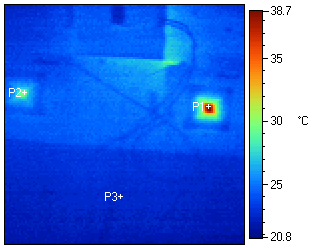
Description
|
Temperature
|
Altera (P1)
|
38.72 oC
|
CoolRunner (P2)
|
29.5 oC
|
Ambient (P3)
|
22.88 oC
|
Xilinx XCR3256XL vs. Altera EPM3256AE
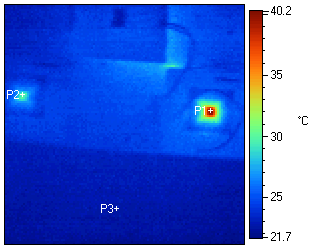
Description
|
Temperature
|
Altera (P1)
|
40.23 oC
|
CoolRunner (P2)
|
29.5 oC
|
Ambient (P3)
|
22.88 oC
|
Xilinx XCR3256XL vs. Lattice M4LV-128/64
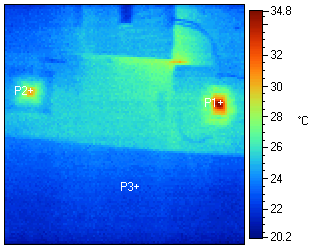
Note: 128 macrocell Lattice device
Description
|
Temperature
|
Lattice (P1)
|
34.83 oC
|
CoolRunner (P2)
|
30.68 oC
|
Ambient (P3)
|
22.88 oC
|
Xilinx XCR3256XL vs. Lattice ispLSI2192VE
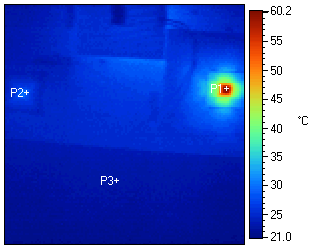
Note: 192 macrocell Lattice device
Description
|
Temperature
|
Lattice (P1)
|
60.2 oC
|
CoolRunner (P2)
|
29.3 oC
|
Ambient (P3)
|
23.21 oC
|
Xilinx XCR3256XL vs. Cypress 37256VP160

Description
|
Temperature
|
Cypress (P1)
|
34.3 oC
|
CoolRunner (P2)
|
30.36 oC
|
Ambient (P3)
|
25.55 oC
|
Infrared Solutions Information:
Infrared Solutions SnapShot® infrared imaging technology was used to produced the thermal images of "CoolRunner vs. the Competition". The infrared camera operates
similar to a digital camera and captures high definition, fully calibrated infrared images. It displays color IR images on a 4-inch LCD display through customized software that adds reference temperatures on a gradient scale. It is highly
portable, weighing only 4.5 pounds, and is battery powered. It is simple to operate and uses familiar computer interface buttons and menu system. As the world's first imaging radiometer under $15,000, the IR SnapShot has dramatically reduced
the entry level cost of infrared imaging and temperature measurement.
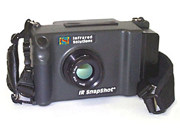 |
Features Overview:
|
More Information:
Click here for more information about our CPLD Products.
| 



